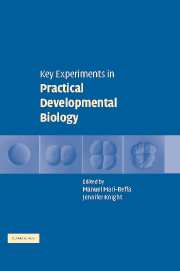Book contents
- Frontmatter
- Contents
- List of contributors
- Preface
- Introduction
- SECTION I GRAFTINGS
- SECTION II SPECIFIC CHEMICAL REAGENTS
- SECTION III BEAD IMPLANTATION
- SECTION IV NUCLEIC ACID INJECTIONS
- SECTION V GENETIC ANALYSIS
- SECTION VI CLONAL ANALYSIS
- 14 The role of the gene apterous in the development of the Drosophila wing
- 15 Extramacrochaetae, an example of a gene required for control of limb size and cell differentiation during wing morphogenesis in Drosophila
- 16 Hedgehog transduction pathway is involved in pattern formation in Drosophila melanogaster tergites
- SECTION VII IN SITU HYBRIDIZATION
- SECTION VIII TRANSGENIC ORGANISMS
- SECTION IX VERTEBRATE CLONING
- SECTION X CELL CULTURE
- SECTION XI EVO–DEVO STUDIES
- SECTION XII COMPUTATIONAL MODELLING
- Appendix 1 Abbreviations
- Appendix 2 Suppliers
- Index
- Plate Section
- References
15 - Extramacrochaetae, an example of a gene required for control of limb size and cell differentiation during wing morphogenesis in Drosophila
Published online by Cambridge University Press: 11 August 2009
- Frontmatter
- Contents
- List of contributors
- Preface
- Introduction
- SECTION I GRAFTINGS
- SECTION II SPECIFIC CHEMICAL REAGENTS
- SECTION III BEAD IMPLANTATION
- SECTION IV NUCLEIC ACID INJECTIONS
- SECTION V GENETIC ANALYSIS
- SECTION VI CLONAL ANALYSIS
- 14 The role of the gene apterous in the development of the Drosophila wing
- 15 Extramacrochaetae, an example of a gene required for control of limb size and cell differentiation during wing morphogenesis in Drosophila
- 16 Hedgehog transduction pathway is involved in pattern formation in Drosophila melanogaster tergites
- SECTION VII IN SITU HYBRIDIZATION
- SECTION VIII TRANSGENIC ORGANISMS
- SECTION IX VERTEBRATE CLONING
- SECTION X CELL CULTURE
- SECTION XI EVO–DEVO STUDIES
- SECTION XII COMPUTATIONAL MODELLING
- Appendix 1 Abbreviations
- Appendix 2 Suppliers
- Index
- Plate Section
- References
Summary
OBJECTIVE OF THE EXPERIMENT The goal of these experiments is to study the effects on cell proliferation and vein patterning caused by mutations in theemc gene during development of the imaginal wing discs. To this end, two different experiments will be performed:
Twin analysis. Clones ofemc mutant cells will be generated by mitotic recombination at the same time that “twin” clones are generated that are emc+ (control). With this experiment we will be able to analyse the difference in size (number of cells), shape and distribution ofemc mutant clones in comparison to control twins.
Minute analysis.emc1M+/emc1M+ mutant cells will be induced in aM−/M+ mutant background. In aM−/M+ heterozygous backgroundM+/M+ cells exhibit a growth advantage that allows clones initiated early in development to occupy large wing territories. This experiment, which supports the notion that size control is not based on cell proliferation rate control, will allow us to study the effects caused by the presence of a large region ofemc mutant cells in the growing wing.
DEGREE OF DIFFICULTY Moderate.
INTRODUCTION
The development of the imaginal wing discs ofDrosophila melanogaster is a classic model system for analysis of the cellular and genetic bases of cell proliferation and pattern formation. Each wing disc gives rise to one wing and one-half of the adult thorax. These discs arise from a group of 20–40 cells that are segregated from the embryonic cells during early embryogenesis. These founder cells proliferate extensively during the larval stages until the beginning of metamorphosis.
- Type
- Chapter
- Information
- Key Experiments in Practical Developmental Biology , pp. 178 - 189Publisher: Cambridge University PressPrint publication year: 2005



